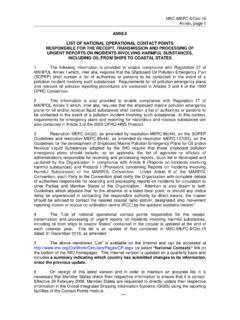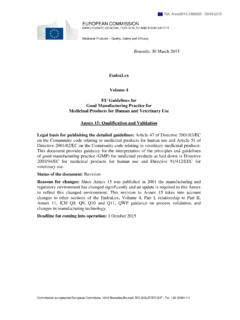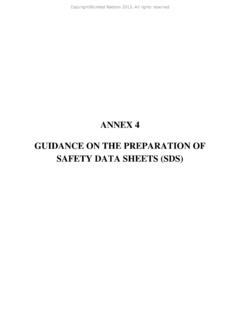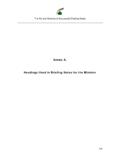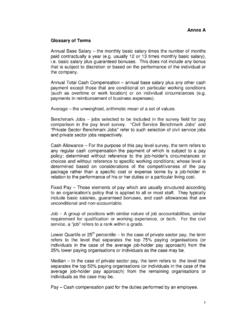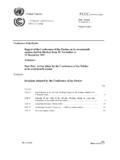Transcription of Annex 5 - WHO
1 271 Annex 5 Recommendations to assure the quality, safety and efficacy of tetanus vaccines (adsorbed)Replacement of Annex 2 of WHO Technical Report Series, No. 800, and Annex 5 of WHO Technical Report Series, No. 927 Introduction 273 Scope of the Recommendations 279 General considerations 279 Part A. Manufacturing recommendations Definitions General manufacturing recommendations Production, processing and control Filling and containers Control of final product Records Retained samples Labelling Distribution and transport Stability, storage and expiry date 300 Part B. Nonclinical evaluation of tetanus vaccines Introduction Nonclinical testing and characterization of intermediates and in-process materials Nonclinical characterization of formulated vaccine 305 Part C.
2 Clinical evaluation of tetanus vaccines Introduction Assessment of immunogenicity in humans Safety evaluation Post-marketing studies and surveillance 314 Part D. Recommendations for NRAs General Release and certification by the NRA 315 Authors and acknowledgements 315 References 317272 WHO Technical Report Series No. 980, 2014 WHO Expert Committee on Biological Standardization Sixty-third reportAppendix 1 Model protocol for the manufacturing and control of tetanus vaccines (adsorbed) 322 Appendix 2 Model certificate for the release of tetanus vaccines (adsorbed) by NRAs 332 Recommendations published by WHO are intended to be scientific and advisory in nature. Each of the following sections constitutes recommendations for national regulatory authorities (NRAs) and for manufacturers of biological products.
3 If an NRA so desires, these WHO Recommendations may be adopted as definitive national requirements, or modifications may be justified and made by the NRA. It is recommended that modifications to these Recommendations be made only on condition that modifications ensure that the vaccine is at least as safe and efficacious as that prepared in accordance with the Recommendations set out below. The parts of each section printed in small type are comments or examples intended to provide additional guidance to manufacturers and 5273 IntroductionTetanus vaccines are among the most frequently used vaccines worldwide and have been remarkably successful products. Their widespread use in routine immunization programmes has resulted in a significant decrease in the incidence of tetanus in both developed and developing countries.
4 Ensuring good coverage of childhood vaccinations and appropriate booster immunization of adults are essential to maintaining protection against tetanus (1).Single-antigen tetanus toxoid vaccine ( containing only tetanus toxoid) is almost never used in infants and children. Instead, tetanus toxoid is delivered as part of a primary immunization series in which it is generally presented in combination with diphtheria toxoid alone, or with diphtheria and whole-cell pertussis (DTP), or with diphtheria and acellular pertussis antigens (DTaP). Tetanus toxoid is also present in other combined vaccines that may contain, in addition to diphtheria and pertussis antigens, inactivated poliovirus, hepatitis B surface antigen or Haemophilus influenzae type b capsular polysaccharide conjugates, or some combination of these.
5 Monovalent tetanus toxoid may be used more frequently for immunizations in adults and adolescents to reinforce immunity, which is essential because immunity to tetanus is induced only by vaccination. However, even for booster immunizations in adults, tetanus vaccines are often combined with other vaccines, and are generally formulated with a lower amount of antigens, particularly of diphtheria and acellular pertussis, when compared with vaccines intended for primary immunization (1). The potent immunogenicity of tetanus toxoid has also led to its use as a carrier protein in polysaccharide-protein conjugate vaccines such as Haemophilus influenzae type b conjugate vaccines (2).The need for and use of tetanus vaccine will continue since immunity to tetanus is induced only by immunization because the pathogenic dose is lower than the immunogenic dose, and recovery from clinical tetanus does not result in protection against further episodes.
6 The widespread use of tetanus vaccine, combined with improved standards of hygiene, has significantly reduced the incidence of tetanus disease in developed countries. However, neonatal tetanus remains a problem in developing countries, with infections occurring primarily through the unhealed umbilicus, and the mortality rate is high even with hospital care (3). The impact of neonatal tetanus is substantial and accounts for the most deaths from vaccine-preventable diseases, with an estimated 59 000 babies dying from tetanus in 2008 (4, 5).Widespread coverage has not been achieved in low-income countries owing to the prohibitive cost of vaccination, which results from the requirements for multiple doses, parenteral administration by trained medical staff, and the need for a cold chain.
7 Efforts are thus needed to improve the vaccine in terms of lowering the number of doses by developing slow-release products (6, 7), 274 WHO Technical Report Series No. 980, 2014 WHO Expert Committee on Biological Standardization Sixty-third reportdelivering the vaccine without needles (8) and improving the formulation and stability to eliminate the need for cold-chain storage. Subunit vaccines produced by recombinant technology that include a nontoxic receptor binding domain, the Hc fragment of tetanus toxin, are in various stages of development, and have shown promising results during preclinical evaluations (9 11). However, there are no data available from clinical trials in of WHO Requirements and Recommendations, and standardizationThe first WHO Requirements for tetanus toxoid vaccines were published in 1964 (12).
8 These were revised in 1978 (13), with addenda in 1986 (14) and 1989 (15), and with further amendments made to the potency section during a consultation in 2003 (16).The development of tetanus toxoid vaccines, and the publication of requirements for their manufacture and quality control, was helped considerably by the availability of international standards and international reference first milestone in the global standardization of tetanus toxoid was the establishment of the International Standard for tetanus antitoxin, equine in 1928 (17), which was replaced in 1969 (18). The availability and use of this preparation enabled toxoids to be assessed in terms of their ability to produce tetanus antitoxin in humans, and allowed protective units for antitoxin to be defined in International Units (IUs).
9 The first standard for tetanus toxoid established by WHO was the First International Standard for tetanus toxoid, plain (established in 1951). The IU was defined as the immunizing activity of mg of the international standard, and was approximately equivalent to the existing German protective unit, the Schutzeinheit (19). This unit was defined on the basis of results obtained in guinea-pig challenge assays. At the Expert Committee meeting in 1958, it was noted that in mice, adsorbed preparations of tetanus toxoid could not be assayed with validity against the nonadsorbed international standard, and a recommendation was made that a separate International Standard for tetanus toxoid, adsorbed was needed (20). Thus the First International Standard for tetanus toxoid, adsorbed was prepared for determining the potencies of vaccines containing tetanus toxoid (adsorbed), and was established in 1966 (21).
10 This standard was assigned an activity of 120 IU per ampoule (where 1 mg was determined to be equivalent to IU of a previously established international standard (22), based on the results obtained in guinea-pig challenge assays). The International Standard for tetanus toxoid, adsorbed has been replaced at 10 20-year intervals with IUs assigned by WHO that have been based solely on calibration in guinea-pig challenge assays relative to the existing standard (23 27). Annex 5275 The Requirements published in 1964 specified assays against an international standard vaccine but required no minimum potency. A study published in 1970 provided evidence of a positive correlation between the amount of adsorbed tetanus toxoid in IUs (determined in guinea-pigs) and the antitoxin response in infants immunized with different DTP vaccines (28).










